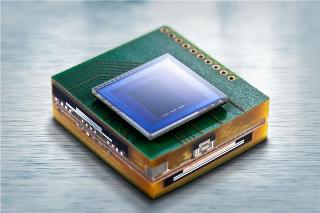Oct 10 2014
Measuring only a few cubic millimeters, a new type of camera module might soon be integrated into future driver assistance systems to help car drivers facing critical situations. The little gadget can be built into the vehicle without taking up space. The way it works is particularly reliable, thanks to its special encapsulation.
 Cross-section of the microcamera module, with the image sensor mounted on the Printed Circuit board. (© Fraunhofer IZM)
Cross-section of the microcamera module, with the image sensor mounted on the Printed Circuit board. (© Fraunhofer IZM)
All too often, a driver has only fractions of a second to decide when facing a potential car accident: A brief moment of distraction, overtiredness or inattention – there are several reasons why the number of accidents in Germany is high, on the autobahns most of all. According to data from the Federal Statistical Office, the number of deadly casualties on German autobahns in 2013 rose by more than eight percent when compared to the prior year. Driver assistance systems could help prevent these unfortunate incidents - or at least help reduce them. Microcameras are indispensable helpers: They register potential risks even when the driver has not yet even noticed them - and could warn him or her just in time.
Researchers at the Fraunhofer Institute for Reliability and Microintegration IZM in Berlin developed a microcamera module that aims to achieve this. The camera detects, for instance, traffic signs that could easily be overlooked on the autobahn, and thus could lead to serious or fatal accidents. One particular feature of the system: in contrast to the conventional driver assistance systems on the market, the image material is processed – and thus, the traffic signage interpreted – directly inside the camera, since it is equipped with an integrated processor for image processing. After the integrated image sensor has recorded the images, the processor evaluates the frames. “The video itself no longer has to – as previously the case – be sorted and analyzed by an interposing system. Instead, only the relevant signals are transmitted,” says Andreas Ostmann, a graduate of physics and the group manager at IZM. The advantage for traffic signal detection: The data volumes to be transmitted and processed turn out to be much less – by many times over. Since the detection of all signals can be adapted to all traffic signs that are typical of the country, there are no kinds of restrictions with regard to their areas of use: the microcamera detects stop signs just like speed limits, no-passing zones or one-way street signs. For example: through a signal in the dashboard, they could advise the driver and thus improve both driving comfort and safety.
At a size of only 16x16x12 cubic millimeters, including optics and 16x16x4.6 cubic millimeters without the optics, the microcamera module is smaller than the driver assistance cameras currently installed with edge lengths of 20x20x20 cubic millimeters (without optics). This miniaturization was made possible by the expertise of the IZM researchers in the assembly and interconnection technology department. A total of 72 passive and 13 active components (such as LEDs, DC-to-DC converters, memory chip, image sensor and image processor) had to be positioned within the module in an especially space-saving manner. The research team succeeded with this: in just one attempt, the volume of the camera was reduced to 3 cubic centimeters with the optics, and 1.2 cubic centimeters without the optics.
Another advantage of the newly developed module: all components are integrated directly into the PC board from glass fiber and epoxy resin. Experts called this assembly technology “embedding.” By encapsulating the electronic components, the microcamera is now impervious to vibrations on uneven street surfaces.
“Our system can not only be used to detect traffic signs. If one programs the software accordingly, it is also possible to detect road markings. In this case, the camera is combined with a lane departure assistant. Since it also controls motion detection and detects objects such as animals, people, and their position, it can be readily coupled with a brake assistant or pedestrian safety system,” Ostmann explains. Another scenario: mounted on the dashboard, the miniature system could monitor the cabin of vehicles and send an alarm for microsleep. If the camera detects that the driver’s eyes are closed for somewhat longer than a second, an alarm is triggered. Other potential applications for the miniature camera could be anti-theft protection and quality control. For this purpose, only the image processing algorithms would have to be adjusted accordingly.